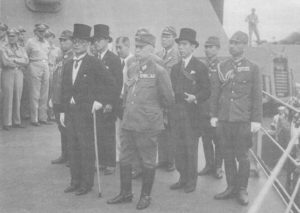- Author
- Ashmore, Edward, Sir, Admiral of the Fleet, RN
- Subjects
- WWII operations
- Tags
-
- RAN Ships
- None noted.
- Publication
- December 2005 edition of the Naval Historical Review (all rights reserved)
When the signal “Cease hostilities against Japan” was hoisted in the British Task Force, awaiting a broadcast to the Fleet by Admiral Halsey USN, a kamikaze splashed into the sea just 300 yards astern of HMS Indefatigable. The Fleet remained under practically continuous air attack, and Admiral Halsey’s broadcast concluded by instructing everybody that the end of hostilities meant that Japanese aircraft were now to be shot down “in a friendly manner”.
On 12 August 1945 the main body of the BPF departed for Sydney. Vice Admiral Rawlings in HMS King George V stayed and was joined soon afterwards by Admiral Sir Bruce Fraser in HMS Duke of York (Flagship BPF), having left Guam immediately after the ceasefire and the British ships anchored with the Americans in Tokyo Bay on 27 Aug 1945.

On Sunday 2 Sep 1945 the delegates for the surrender assembled on the verandah deck of the battleship USS Missouri. We all went in our working uniform, the British in white tropical shorts, the Americans in their khaki. A table was laid out with a chair each side of it, obviously for the surrender ceremony. The Japanese delegates arrived by boat, led by Shigemitsu, the Foreign Minister, in a black morning coat and top hat, limping and carrying a stick.
General MacArthur, who was to sign for the United Nations, walked with Admiral Nimitz (for the USA) to their place behind the table. MacArthur read the surrender terms aloud, and the documents were produced. The Japanese, Shigemitsu and General Umezo, came forward and signed. MacArthur then signed, flanked by US General Wainwright (whom he had left behind in Corregidor) and General Percival (the last British commander of Singapore). Both these officers had been flown out of prison in Manchuria, and were as thin as rakes and swaying on their feet. After Nimitz and his team, Admiral Fraser signed for Great Britain, with Rawlings and Rear Admiral Brind flanking him as he did so. As the signing took place, aircraft from the fleet flew over us in formation – not least among the instruments of victory.
When all was done, MacArthur led the Allied representatives away, and the rest of us started chatting and talking, laughing and finding our friends. Only the Japanese remained fallen in, silent in their humiliation in their own place on deck – eventually shepherded into a boat and away.
We had all been invited to Missouri’s wardroom, where there was a cold collation of sorts but, of course, no alcohol. The press and photographers swarmed around. Eventually I went back with my admiral to HMS Newfoundland (cruiser), where we could have a drink and celebrate the occasion properly. It was the end of a long haul.
The other British ships sailed, but Newfoundland remained off Yokosuka as guardship, with RADM Brind as Senior British Officer Afloat. Commodore Collins RAN took over naval officer ashore duties in the British Embassy in Tokyo.
(Extract by then Lieutenant Edward Ashmore, from his biography The Battle and the Breeze – the naval reminiscences of Admiral of the Fleet Sir Edward Ashmore) (1997).




